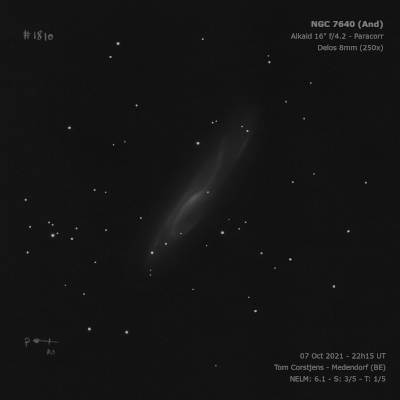
William Herschel discovered NGC 7640 = H II-600 = h2236 on 17 Oct 1786 (sweep 613) and recorded "pB, mE a little np to sf but nearly in the meridian, lbM, resolvable, about 5' long and 1.5' broad." On 1 Oct 1828, JH logged "F; L; mE from a bright to a faint star; vlbM; 2 1/2' l, 20" br. See fig. 60."
200/250mm - 8" (11/8/80): faint, large, very elongated streak N-S. There are stars at both the north and south end.
400/500mm - 17.5" (8/8/91): moderately bright, very large, very elongated 4:1 N-S, 7.0'x1.5'. The large, slightly brighter middle bulges out a little. A mag 13.5 star is at the SE edge of the core 33" from the center. Bracketed by two mag 11 stars at the north end 3.0' NNW of center and just west of the south end 2.6' SSW of center. An extremely faint mag 15 star is embedded near the north end.
600/800mm - 24" (10/4/13): at 200x appeared bright, very large, nearly edge-on 4:1 N-S, ~6.5'x1.5'. Very asymmetric appearance with a brighter, elongated core, 1.0'x0.5', which is oddly angled to the major axis in PA 20° (SSW-NNE). A mag 14 star is just off the SE side of the core. The galaxy dims more noticeably on the south side, but is brighter along the western half (DSS shows this is a long spiral arm). A mag 11 star is just west of the northern end of the galaxy [3.1' NNW of center] and two mag 14.5-15 stars that are collinear with the mag 11 star are superimposed on the north side. The northern half of the galaxy is also asymmetric with a slightly brighter strip (arm) extending N-S and a very low surface brightness (outer arm) near the mag 11 star. Additional mag 11 stars bracket the galaxy just west of the south end and 1.8' NE of center.
Notes by Steve Gottlieb